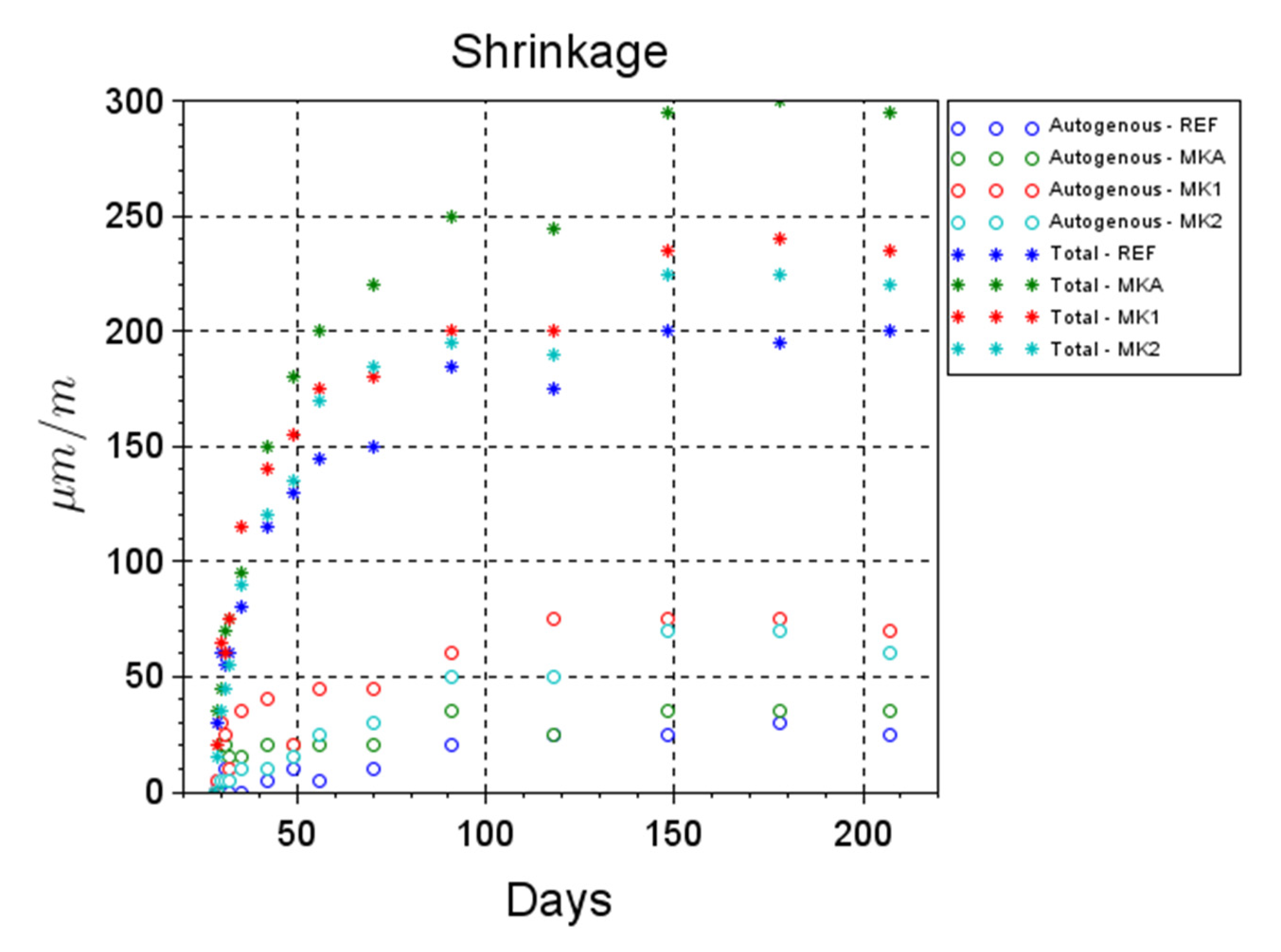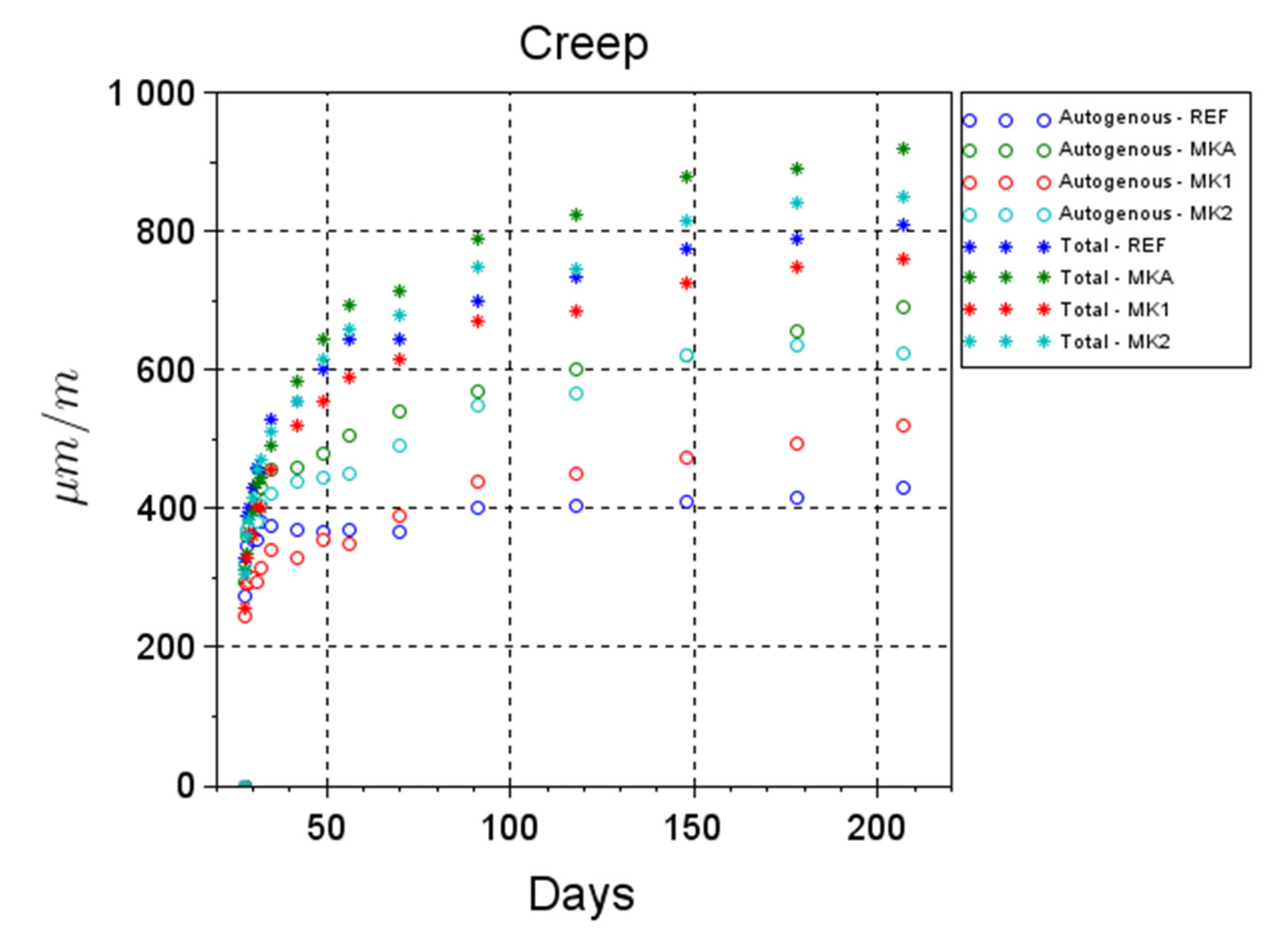Experimental Study of Blended Binders with Metakaolin
Abstract
:1. Introduction
2. Concrete Mix-Designs
- a concrete mix-design as used for usual foundations and slabs based on CEM III/A type cement,
- a high performance concrete (HPC) mix-design as used in columns of a high-rise building based on CEM I type cement.
- Target slump: 200 ± 30 mm;
- Workability holding time: 90 min;
- Exposure classes: XC3—XC4—XF1—XD1 (XC: corrosion induced by carbonation, XF: freeze-thaw attack and XD: corrosion induced by chlorides from de-icing);
- Strength class:
- C40/50 for the raft/slab mix-design, i.e., the concrete must reach a characteristic resistance of 40 MPa on cylinders and 50 MPa on cubes at 28 days;
- C60/75 for high-rise buildings, i.e., the concrete must reach a characteristic resistance of 60 MPa on cylinders and 75 MPa on cubes at 28 days.
3. Metakaolin Products
- their chemical characteristics: chemical composition, mineralogical composition, degree of crystallinity,
- the purity of the initial kaolinite: the impurities act as “diluents” (the mechanical strength of concrete incorporating MK decreases when the level of impurities increases),
- the thermal process: calcination temperature, duration…
- the post-calcination treatment: grinding, sieving…
4. Experimental Investigations
4.1. Workability Tests
4.2. Hardened Concrete Tests
4.3. Durability Performance
4.4. Long Term Behavior
5. C60/75 Concrete
5.1. Workability Results
5.2. Hardened Concrete Results
5.3. Durability Tests
5.3.1. Porosity
5.3.2. Carbonation
5.3.3. Chloride Migration Coefficients
5.4. Long Term Behavior
6. C40/50 Concrete
6.1. Workability Results
6.2. Hardened Concrete Results
6.3. Durability Tests
6.3.1. Porosity
6.3.2. Carbonation
6.3.3. Chloride Migration Coefficients
7. Conclusions
- For high or medium strength concretes, the workability over time is better with the different MKs.
- For high performance concrete, the use of MK in replacement of SF leads to very close or better 28dys strength, but the long term performance tends to be stabilized after 28 days, compared to the reference concrete which continues to increase. This evolution of compressive strength is not noticeable for the medium strength concrete, tending to confirm the role of SF. For medium strength concrete, the use of flash calcined metakaolin seems to be less efficient with a high content of MK, comparatively to a kiln metakaolin production.
- The other mechanical properties (Young modulus, flexural strength, tensile strength) are not significantly affected.
- Porosity is improved at lower metakaolin content but appears to be similar to the reference concrete at 15% content. Porosity must be nevertheless analyzed with care because porosity is a global durability feature. Indeed, this result does not take into consideration the size of pores that are usually smaller for MK concretes.
- Accelerated carbonation ingress is null for high performance concrete (at least for the tested period of time), but it is slightly higher for medium strength concretes. Portlandite is indeed in lower content in concretes with MK, facilitating the migration of CO2. But the presence of smaller pores for MK has an opposite effect. This effect is not noticeable on 8% substitution, but 15% substitution highlights lower carbonation depths than 8%.
- Migration coefficients are lower for both concretes and highlight an improved resistance against chloride ions diffusion.
- Total creep and shrinkage are larger than the reference concrete for the high performance concrete. Nevertheless, compared to the Eurocode models, the long term values are lower. As Eurocode models for creep and shrinkage being on the safe side, the less good results of MK concretes compared to the reference HPC concrete may be not a major issue.
Author Contributions
Funding
Institutional Review Board Statement
Informed Consent Statement
Data Availability Statement
Conflicts of Interest
References
- Bakera, A.T.; Alexander, M. Use of metakaolin as a supplementary cementitious material in concrete, with a focus on durability properties. Rilem Tech. Lett. 2019, 4, 89–102. [Google Scholar] [CrossRef] [Green Version]
- Sullivan, M.S.; Chorzepa, M.G.; Hamid, H.; Durham, S.; Kim, S.S. Sustainable materials for transportation Infrastructures: Comparison of three commercially available metakaolin products in binary cementitious systems. Infrastructures 2018, 3, 17. [Google Scholar] [CrossRef] [Green Version]
- Muhd Norhasri, M.S.; Hamidah, M.S.; Fadzil, A.M.; Megawati, O. Inclusion of nano metakaolin as additive in Ultra High-Performance Concrete (UHPC). Constr. Build. Mater. 2016, 127, 167–175. [Google Scholar] [CrossRef]
- Kim, H.K.; Hwang, E.A.; Lee, H.K. Impacts of metakaolin on lightweight concrete by type of fine aggregate. Constr. Build. Mater. 2012, 36, 719–726. [Google Scholar] [CrossRef]
- Hassan, A.A.A.; Lachemi, M.; Hossain, K.M.A. Effect of metakaolin and silica fume on the durability of self-consolidating concrete. Cem. Concr. Compos. 2012, 34, 801–807. [Google Scholar] [CrossRef]
- Tafraoui, A.; Escadeillas, G.; Vidal, T. Durability of the Ultra High Performances Concrete containing metakaolin. Constr. Build. Mater. 2016, 112, 980–987. [Google Scholar] [CrossRef]
- Cassagnabère, F.; Diederich, P.; Mouret, M.; Escadeillas, G.; Lachemi, M. Impact of metakaolin characteristics on the rheological properties of mortar in the fresh state. Cem. Concr. Compos. 2013, 37, 95–107. [Google Scholar] [CrossRef]
- Jiang, G.; Rong, Z.; Sun, W. Effects of metakaolin on mechanical properties, pore structure and hydration heat of mortars at 0.17 w/b ratio. Constr. Build. Mater. 2015, 93, 564–572. [Google Scholar] [CrossRef]
- Siddique, R.; Kaur, A. Effect of metakaolin on the near surface characteristics of concrete. Mater. Struct. 2011, 44, 77–88. [Google Scholar] [CrossRef]
- Al-Alaily, H.S.; Hassan, A.A.A. Time-dependence of chloride diffusion for concrete containing metakaolin. J. Build. Eng. 2016, 7, 159–169. [Google Scholar] [CrossRef]
- AFNOR. NF EN 206/CN. Concrete—Specification, Performance, Production and Conformity—National Addition to the Standard NF EN 206; AFNOR: Paris, France, 2014. [Google Scholar]
- AFNOR. NF EN 12350-2. Testing Fresh Concrete—Part 2: Slump test; AFNOR: Paris, France, 2019. [Google Scholar]
- AFNOR. NF EN 12390-3. Testing Hardened Concrete—Part 3: Compressive Strength of Test Specimens; AFNOR: Paris, France, 2019. [Google Scholar]
- AFNOR. NF EN 12390-5. Testing Hardened Concrete—Part 5: Flexural Strength of Test Specimens; AFNOR: Paris, France, 2019. [Google Scholar]
- AFNOR. NF EN 12390-6. Testing Hardened Concrete—Part 6: Tensile Splitting Strength of Test Specimens; AFNOR: Paris, France, 2012. [Google Scholar]
- AFNOR. NF EN 12390-13. Testing Hardened Concrete—Part 13: Determination of Secant Modulus of Elasticity in Compression; AFNOR: Paris, France, 2014. [Google Scholar]
- AFNOR. NF P18-459. Concrete—Testing Hardened Concrete—Testing Porosity and Density; AFNOR: Paris, France, 2010. [Google Scholar]
- AFNOR. XP P18-458. Tests for Hardened Concrete—Accelerated Carbonation Test—Measurement of the Thickness of Carbonated Concrete; AFNOR: Paris, France, 2008. [Google Scholar]
- AFNOR. XP P18-462. Testing Hardened Concrete—Chloride Ions Migration Accelerated Test in Non-Steady-State Conditions—Determining the Apparent Chloride Ions Diffusion Coefficient; AFNOR: Paris, France, 2012. [Google Scholar]
- Paul Acker, Z.P.; Bažant, J.C.; Chern, C.; Huet, F.H.; Alou, F.; Fagerlund, G.; Hansen, T.C.; Mamillan, M.; Schwesinger, P.; Ulm, F. RILEM TC 107. Measurement of time-dependent strains of concrete. Mater. Struct. 1997, 32, 507–512. [Google Scholar]
- AFNOR. NF EN 197-1. Cement—Part 1: Composition, Specifications and Conformity Criteria for Common Cements; AFNOR: Paris, France, 2012. [Google Scholar]
- Tongbo, S.; Bin, W.; Lijun, Z.; Zhifeng, C. Meta-Kaolin for High Performance Concrete. In Calcined Clays for Sustainable Concrete; RILEM Bookseries; Scrivener, K., Favier, A., Eds.; Springer: Dordrecht, The Netherlands, 2015; Volume10, pp. 467–477. [Google Scholar]
- Baroghel-Bouny, V. Les Spécificités des Bétons à Hautes Performances; LCPC: Paris, France, 2004. [Google Scholar]
- AFNOR. NF EN 1992-1-1. Eurocode 2: Design of Concrete Structures—Part 2: Concrete Bridges—Design and Detailing Rules; AFNOR: Paris, France, 2006. [Google Scholar]









| Name | Component | Quantity for 1 m3 | Name | Component | Quantity for 1 m3 |
|---|---|---|---|---|---|
| C40/50 | CEM III/A 42.5N PMES | 340 kg | C60/75 | CEM I 52.5N CE CP2 NF | 380 kg |
| Limestone filler | 60 kg | Limestone filler | 90 kg | ||
| Silica fume | 30 kg | ||||
| 0/4mm crushed sand | 870 kg | 0/4mm crushed sand | 800 kg | ||
| 4/20mm crushed aggregate | 950 kg | 4/12.5mm crushed aggregate | 910 | ||
| w/c | 0.53 | w/c | 0.38 | ||
| Admixture | 3.00 kg | Admixture | 5.45 kg |
| Name | MKA | MK1 | MK2 | |||
|---|---|---|---|---|---|---|
| Process | Flash Calcination | Flash Calcination | Traditional Calcination | |||
| Temperature/Duration | 750 °C | 750 °C | 800 °C/5 h | |||
| Chemical analysis | SiO2 | 67% | SiO2 | 55% | SiO2 | 55% |
| Al2O3 | 27% | Al2O3 | 39% | Al2O3 | 40% | |
| K2O + Na2O | 0.13% | K2O + Na2O | 1.00% | K2O + Na2O | 0.80% | |
| Fe2O3 | 2.60% | Fe2O3 | 1.80% | Fe2O3 | 1.40% | |
| TiO2 | 1.40% | TiO2 | 1.50% | TiO2 | 1.50% | |
| CaO + MgO | 1.30% | CaO + MgO | 0.60% | CaO + MgO | 0.30% | |
| Particle size | 70% < 63 µm | 70% < 3 µm | 50% < 10 µm | |||
| Surface area [m2/g] | 16 | 19 | 17 | |||
| Loss of Ignition [%] | 1% | 1% | 1% | |||
| Compressive Strength | Reference | MKA | MK1 | MK2 |
|---|---|---|---|---|
| MPa | 95.4 ± 6.2 | 87.1 ± 1.7 | 86.2 ± 2.3 | 106.3 ± 1.6 |
| Porosity | Reference | MKA | MK1 | MK2 |
|---|---|---|---|---|
| [%] | 11.73 ± 0.12 | 12.83 ± 0.06 | 12.60 ± 0.20 |
| Reference | MKA | MK1 | MK2 | |
|---|---|---|---|---|
| [10−12 m2/s] | 2.12 ± 0.25 | 4.73 ± 0.72 | 2.72 ± 0.23 | 2.17 ± 0.31 |
| [10−12 m2/s] | 1.35 ± 0.13 | 4.62 ± 0.06 | 2.28 ± 0.50 |
| Compressive Strength | Reference | MKA | MK2 |
|---|---|---|---|
| 8% MK content—MPa | 57.6 ± 0.7 | 56.7 ± 3.2 | 57.7 ± 0.8 |
| 15% MK content—MPa | 53.07 ± 2.4 | 60.40 ± 1.2 |
| 8% | 15% | ||||
|---|---|---|---|---|---|
| Porosity | Reference | MKA | MK2 | MKA | MK2 |
| [%] | 14.80 ± 0.09 | 13.93 ± 0.21 | 12.53 ± 0.06 | 15.03 ± 0.42 | 14.60 ± 0.52 |
| 8% | 15% | ||||
|---|---|---|---|---|---|
| Reference | MKA | MK2 | MKA | MK2 | |
| [10−12 m2/s] | 2.09 ± 0.41 | 2.22 ± 0.22 | 2.47 ± 0.17 | 1.76 ± 0.16 | 0.88 ± 0.23 |
| [10−12 m2/s] | 2.08 ± 0.18 | 1.40 ± 0.14 | 1.51 ± 0.77 | 0.62 ± 0.09 | 0.44 ± 0.23 |
Publisher’s Note: MDPI stays neutral with regard to jurisdictional claims in published maps and institutional affiliations. |
© 2021 by the authors. Licensee MDPI, Basel, Switzerland. This article is an open access article distributed under the terms and conditions of the Creative Commons Attribution (CC BY) license (https://creativecommons.org/licenses/by/4.0/).
Share and Cite
Cremona, C.; Vildaer, S.; Cadillac, M. Experimental Study of Blended Binders with Metakaolin. Sustainability 2021, 13, 10548. https://doi.org/10.3390/su131910548
Cremona C, Vildaer S, Cadillac M. Experimental Study of Blended Binders with Metakaolin. Sustainability. 2021; 13(19):10548. https://doi.org/10.3390/su131910548
Chicago/Turabian StyleCremona, Christian, Stéphanie Vildaer, and Maxim Cadillac. 2021. "Experimental Study of Blended Binders with Metakaolin" Sustainability 13, no. 19: 10548. https://doi.org/10.3390/su131910548
APA StyleCremona, C., Vildaer, S., & Cadillac, M. (2021). Experimental Study of Blended Binders with Metakaolin. Sustainability, 13(19), 10548. https://doi.org/10.3390/su131910548





